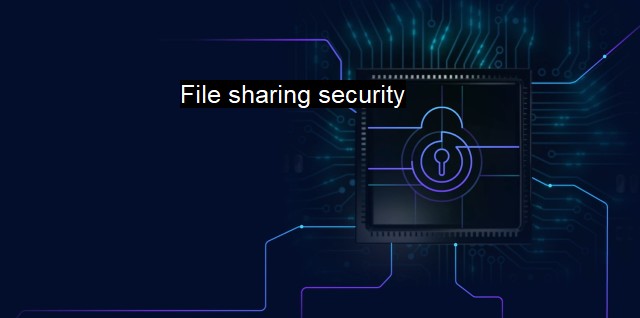What is File sharing security?
Protecting Files and Networks: Understanding the Risks and Enhancing Security in File Sharing
File sharing security refers to protective measures and protocols that safeguard data files being transmitted or shared within a network system—be it between individuals, organizations, or computer systems. In today's technology-driven world, information exchange is routine and vital; thus, the importance of secure file sharing cannot be overemphasized, especially as the threat of digital security breaches looms large.Typically, file sharing involves sending, receiving, or providing access to digital files through different means like email attachments, cloud storage systems, or peer-to-peer networks. this critical process is not without vulnerabilities: unauthorized individuals can intercept files during transmission, data may be corrupted, or sensitive information like private data or intellectual property may be exposed. Such risks require stringent security measures to prevent potential breaches and their disastrous fallout, which include financial losses, reputation damage, and legal penalties.
A crucial measure in file sharing security comes with the application of standard protocols and algorithms, which implement secure transmission channels. One such protocol is the Secure File Transfer Protocol (SFTP), widely deployed for its ability to provide secure file access, transfer, and management through encrypted channels. Secure Socket Layer (SSL) and Transport Layer Security (TLS) are commonplace protocols that protect data-in-transit by creating an encrypted link between the server and the client, thus ensuring any data exchanged between the two parties remain confidential and integral.
Likewise, an essential dimension in file sharing security involves the use of robust access control mechanisms. The rationale is to deliver the access of specific files to authorized parties only. This goal can be achieved through a combination of passwords, one-time pins or codes, biometric data like fingerprints or facial scans, or digital signatures. The idea of security levels with multiple permission layers is often deployed to further secure file sharing by restraining user access rights.
Firewalls are a vital component of file sharing security. These network security systems scrutinize incoming and outgoing network traffic depending on pre-established security rules. They form a barrier between secure and unsecured networks, controlling and managing all forms of data exchange and blocking unauthorized or suspicious data packets.
Backing up data is another significant strategy for secure file sharing, primarily to guard the organization against data loss. Regular, scheduled data backups either locally or offsite, coupled with an efficient disaster recovery plan, ensures business continuity even in the event of severe data loss from cyber-attacks or accidental deletions.
In this cybersecurity-thriving environment, both software and hardware-driven antivirus systems also have an invaluable role in secure file sharing. They provide a comprehensive shield by detecting and eliminating potential threats, both from known and emerging malware and viruses, ensuring safe data transmission. Block cipher systems offered by antivirus solutions also encrypt individual data blocks, enabling safe transmission of information across networks.
File sharing security goes beyond technical strategies. Employees must be educated and regularly trained on safely handling and transmitting data. They should be made aware of phishing attempts, the risks of unknown attachments and insecure networks, duly updating security software, and the necessary procedure during a potential security breach.
To sum up, the emphasis on file sharing security in the backdrop of escalating cyber threats reflects the importance of secure data exchange in safeguarding the interests of enterprises and individuals alike. Through the coherent integration of technological strategies, human centered precautions, secure protocols, antivirus systems, and evolutionary adaptation to rising data breach techniques, secure file sharing can be fortified against the persistent onslaught of cyber-attacks.

File sharing security FAQs
What are the risks of file sharing when it comes to cybersecurity?
File sharing can pose a significant risk to cybersecurity. Sharing files through unsecured channels can expose sensitive data to malicious actors. Without proper encryption and authentication measures, cybercriminals can gain access to your files and use them for fraudulent activities.How can antivirus software help protect against file sharing security risks?
Antivirus software can help protect against file sharing security risks by detecting and removing malware, viruses, and other harmful programs that may infect your files while transferring them. Additionally, antivirus software can also identify and block suspicious network traffic that may be associated with malicious file sharing activity.What are some best practices for secure file sharing?
Some best practices for secure file sharing include using encryption to protect your files, ensuring that file sharing is enabled only on a secure network, avoiding public Wi-Fi for file sharing, and using strong passwords to protect your files. Additionally, it's essential to regularly update your antivirus software and operating system to ensure that you have the latest security patches installed.What are some common file sharing tools that offer strong security features?
Some common file sharing tools that offer strong security features include Google Drive, Dropbox, and Box. These tools use encryption, two-factor authentication, and other security measures to protect your files during transfer and storage. However, it's essential to review the security features of any file sharing tool before using it to ensure that it meets your security requirements.| | A | | | B | | | C | | | D | | | E | | | F | | | G | | | H | | | I | | | J | | | K | | | L | | | M | |
| | N | | | O | | | P | | | Q | | | R | | | S | | | T | | | U | | | V | | | W | | | X | | | Y | | | Z | |
| | 1 | | | 2 | | | 3 | | | 4 | | | 7 | | | 8 | | |||||||